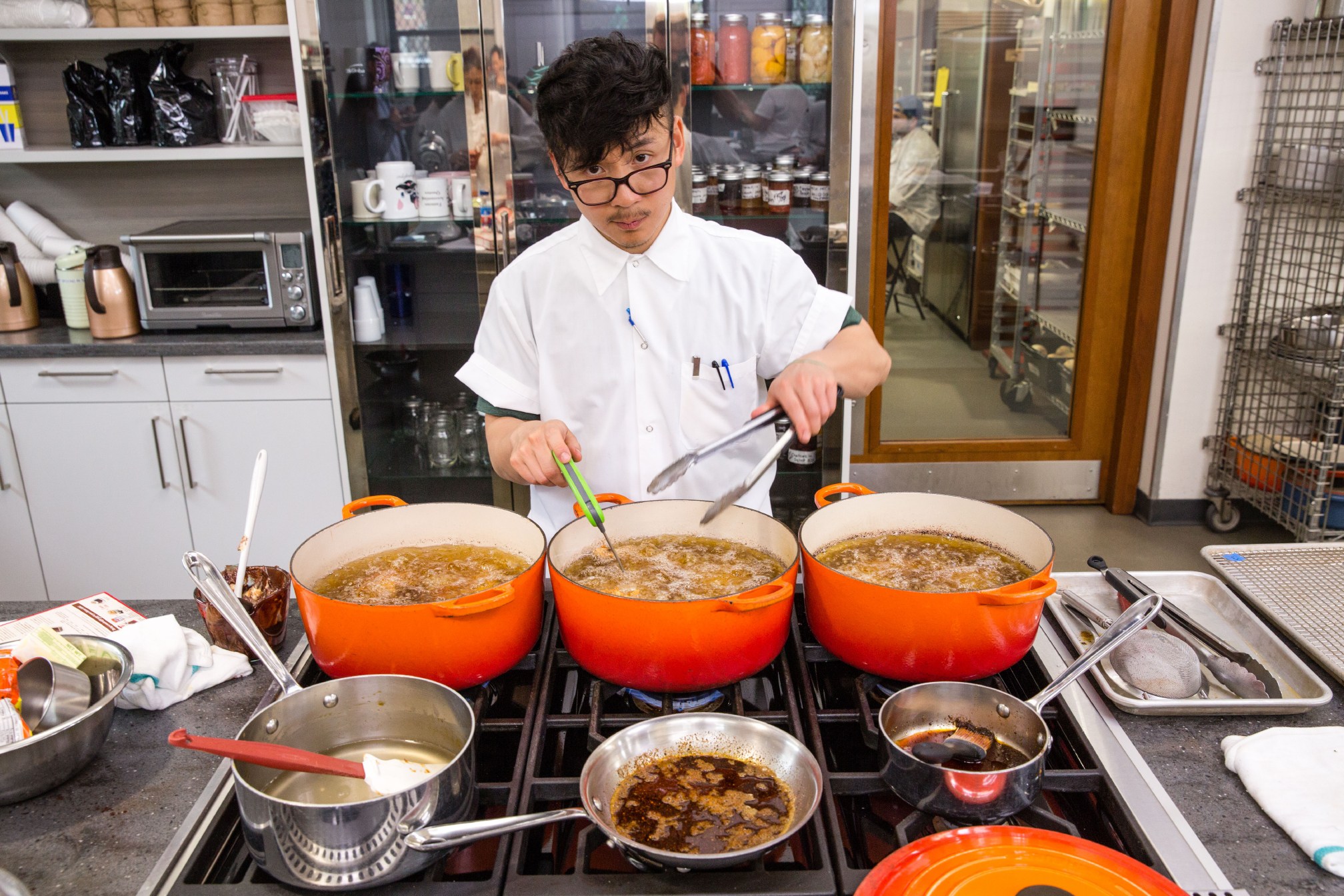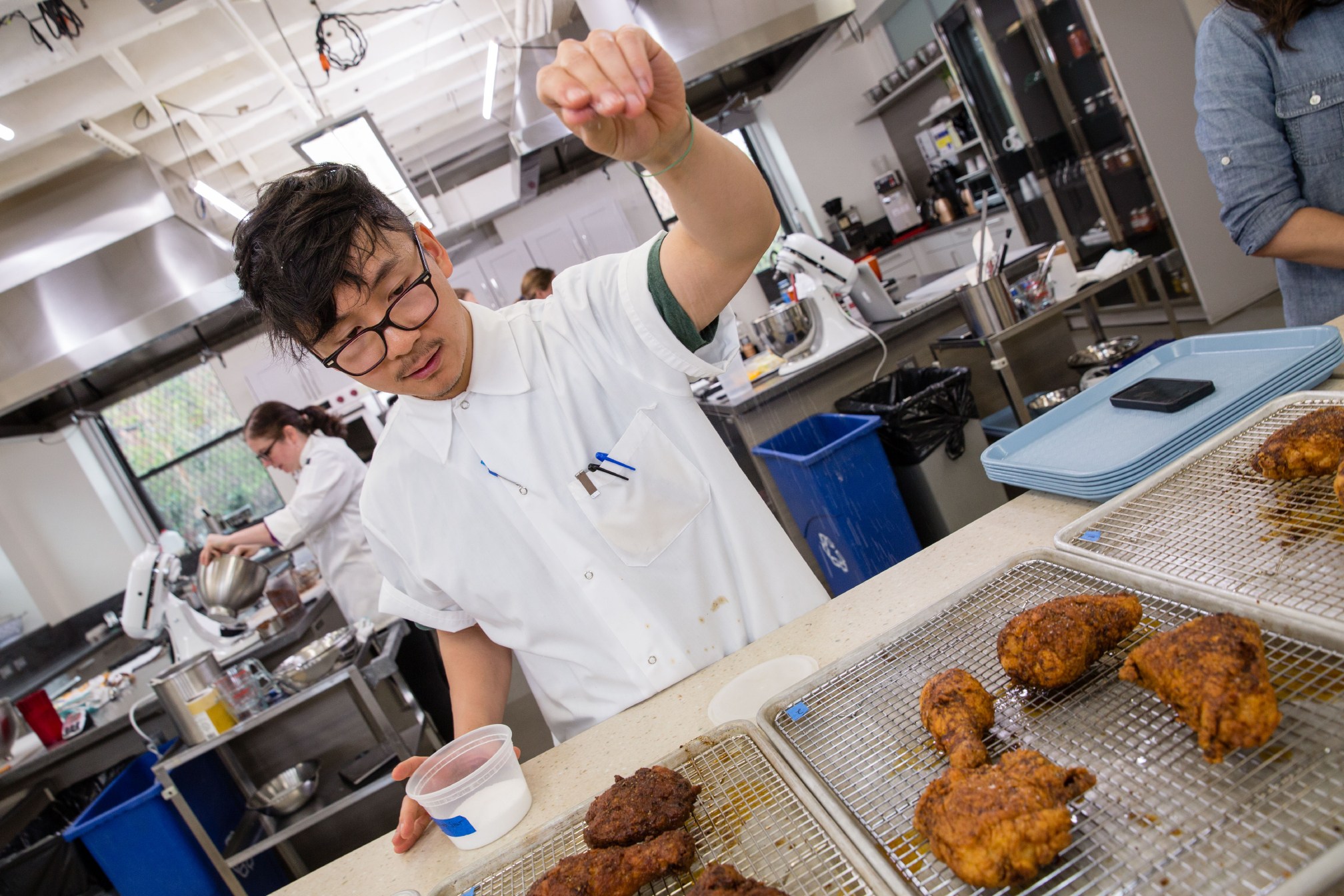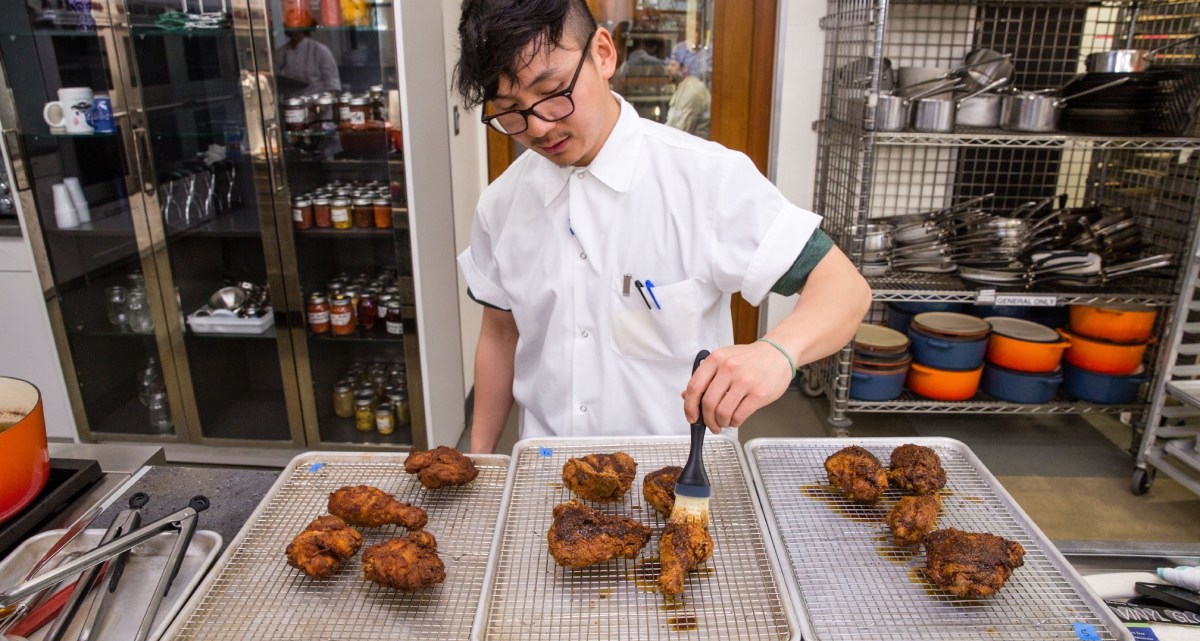In this weekly series, associate editor Tim Chin and test cook Sasha Marx take you behind the scenes of Cook’s Science and give you a glimpse into our recipe development process, from how we come up with recipe ideas, to test kitchen failures, to discoveries we make along the way. This week, Tim comes full circle as he experiments with another fried chicken recipe.
Amidst the chaos of TV filming that Sasha is experiencing for the first time, I have been quietly frying my way through pounds and pounds of chicken. But not just any chicken: I have been developing a recipe for a spicy fried chicken to accompany our upcoming feature about spiciness. And since the departure of ATK’s undisputed, all-time greatest fried chicken queen, senior editor emeritus Diane Unger, the mantle of fried chicken warrior seems to have fallen to me. Diane’s chicken was famous for, among other things, its supremely crispy crust. In her last days here at the company—at the peak of my testing for Koji Fried Chicken—Diane left me with this cryptic (chicken) nugget of wisdom: “There’s so much more to explore . . . If you really want crispy fried chicken, cornstarch is just the tip of the iceberg.”
For years, Diane had championed wheat flour only, or a blend of wheat flour and cornstarch, for the dredges in her Southern-style fried chicken recipes. More recently, she had developed a Hawaiian-Style Fried Chicken recipe using potato starch to good effect. But that’s as far as she went. She never officially published a recipe incorporating alternative starches (tapioca, rice flour, etc.) into her dredges.
For this recipe, I needed a super crunchy coating that would hold up well to being lacquered in a flavorful chili oil without sogging out. So I thought I would rappel down the rabbit hole of dredge blends, in hope of finding a coating that would deliver crispier, crunchier fried chicken.

Classic southern fried chicken recipes call for dredging in 100 percent all-purpose flour. But the companies and restaurants that make fried chicken professionally rely on a tailor-made mix of alternative starches to get specific results. While a portion of classic wheat flour contributes important flavor, they may add other starches to create crispier, crunchier products, with long shelf life, or perhaps a thinner, more delicate coating that shatters like glass. And there are starches specially engineered for that.
Taking a cue from “big fried chicken” I set up four different dredge blends in a ratio of 5 parts all-purpose flour to 3 parts alternative starch—the standard ratio of starches for many of Diane’s delicious fried chicken recipes. In this case, I chose cornstarch, tapioca starch, rice flour, and potato starch. I seasoned the dredges lightly and fortified them with baking powder for added crispness and browning. After a quick brine to ensure juicy meat, I dipped the chicken in buttermilk, dredged it, and let it hydrate overnight until the coating was mostly wet-looking. Finally I fried all of the batches in 325 degrees F oil and we tasted them blind, next to a control batch dredged in 100 percent all-purpose flour for comparison.
Here’s how it all broke down, with some cursory team tasting notes:
All-Purpose Flour Only
This coating was decent. These pieces were crunchy and crispy out of the fryer, but a bit delicate. There was a slight toughness to the coating, likely due to too much gluten formation in the hydrated dredge (all-purpose flour is 10 to 12% protein). After thirty minutes, the coating was getting soggy and unappetizing.
All-Purpose Flour & Rice Flour
This crust was much more substantial than the control sample—in a good way. But tasters noted a slightly sweet flavor, a bit like stale cereal. Overall, we felt like this wasn’t the best direction for this particular application.
All-Purpose Flour & Cornstarch
This had more crunch and crispiness than the control, but the coating seemed to flake off when we bit into the chicken moreso than in the other samples. Overall, this was a solid coating, and I can see why so many recipes at ATK employ this blend. After thirty minutes, the coating appeared to stay decently crispy, with only minor patches of sogginess.
All-Purpose Flour & Tapioca Starch
This was our runner-up for favorite blend. The coating was thin, even and shattered a bit when you took a bite. After thirty minutes, this coating stayed moderately crispy, with no patches of sogginess.
All-Purpose Flour & Potato Starch
This blend was the team’s favorite for two reasons: exceptional, satisfying crunch and crispiness, and unmatched staying power. For some, the crunch factor was a little over the top. And even after two hours, this coating stayed crispy. While a few blends produced satisfactory results, this was our clear winner in this application.

Based on this testing, it seems like I found my ideal blend for this recipe’s chicken dredge in all-purpose flour and potato starch. But what’s the reasoning here? After lots of reading—and lots of back and forth with senior editor Paul Adams—the answer is pretty complicated. (And in case you were wondering, fried chicken scientists—and even better, tempura scientists—exist.) Here is what I can gather so far: The starchy dredge absorbs water during the overnight hydration period, but it doesn’t soften up until it hits the hot frying oil.
All starch is made up of granules, and the granules are composed of two kinds of molecules, amylose and amylopectin. When it comes to a crispy coating, it’s the amylose content that really counts.
When they’re in a moist, hot environment—like a hydrated dredge that’s being deep fried—starch granules swell up allowing the amylose starch molecules to move about and separate from one another. Then, as water is evaporated during the frying process, these separate starch molecules lock into place, forming a rigid, brittle network with a porous, open structure that’s crispy.
Both cornstarch and potato starch are relatively high in amylose, at 25 percent and 22 percent, respectively. Tapioca starch is 15 to 18 percent amylose, and rice starch can be even lower. But given that we repeatedly found the potato starch sample to be crunchier than the rest, it’s clear there is more to the crispy equation than the percentage of amylose. What’s making the difference?
Of all the starches I used, potato starch has the largest starch granules (up to 75 microns compared to 5 to 20 microns for cornstarch), and accordingly, the longest amylose molecules. According to starch researcher Peter Trzasko, quoted in Food Product Design magazine, smaller molecules rapidly form a starch gel when exposed to moisture and heat, as our dredges were. Larger molecules cohere but don’t gel as readily: “[p]otato and tapioca have a molecular weight so much higher than that of corn that it actually makes it more difficult for the molecules to associate.” It seems likely that the water is more easily and thoroughly evaporated from a potato-starch dredge during frying, since it’s not trapped in a gel. The result is a denser coating with brittle crunch, and one that is less quick to retrograde and become chewy or soggy.
This paper corroborates that granule size appears to correlate positively with the perception of crunch. But it’s complicated.
I now understand the need for starch scientists. I’ve been buried in many contradictory findings after reading one too many independent studies. Part of the issue is the specificity of my recipe: I can’t find many studies that mimic or even loosely follow my exact testing conditions. Unlike a lab or academic setting, cooking doesn’t happen in a bubble. I can’t control every single variable in such a complex system as cooking. Instead, it’s useful to use scientific research to inform and guide my testing. In the end, we have to trust our palates and ask as simple question: Does this taste good? As for my fried chicken, for now I’m happy I’ve found a coating that’s undeniably crispy, crunchy, and long-lasting.
Do you have experience with alternative starches and fried chicken? Any tips or insights into the test results? Let us know in the comments below.
[Editor’s Note: Be sure to check back next week on Cook’s Science to see Tim’s final fried chicken recipe!]
Photography by Steve Klise.




